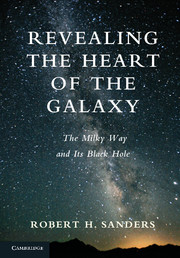Book contents
- Frontmatter
- Contents
- Acknowledgements
- 1 Introduction: The Luminous Pathway
- 2 The Discovery of the Milky Way Galaxy
- 3 The New Physics
- 4 Parting the Veil with Radio Astronomy
- 5 The Violent Universe
- 6 New Windows on the Galactic Center
- 7 The Milky Way as a Barred Spiral Galaxy
- 8 The Evolving View of Active Galactic Nuclei
- 9 The “Paradox of Youth”: Young Stars in the Galactic Center
- 10 Stellar Orbits in the Galactic Center, QED
- 11 Black Holes Here, Black Holes There…
- 12 Traces of Activity: Past, Present, and Future
- 13 After Words: Progress in Astronomy
- References
- Index
3 - The New Physics
Published online by Cambridge University Press: 05 December 2013
- Frontmatter
- Contents
- Acknowledgements
- 1 Introduction: The Luminous Pathway
- 2 The Discovery of the Milky Way Galaxy
- 3 The New Physics
- 4 Parting the Veil with Radio Astronomy
- 5 The Violent Universe
- 6 New Windows on the Galactic Center
- 7 The Milky Way as a Barred Spiral Galaxy
- 8 The Evolving View of Active Galactic Nuclei
- 9 The “Paradox of Youth”: Young Stars in the Galactic Center
- 10 Stellar Orbits in the Galactic Center, QED
- 11 Black Holes Here, Black Holes There…
- 12 Traces of Activity: Past, Present, and Future
- 13 After Words: Progress in Astronomy
- References
- Index
Summary
Revolution
While Kapteyn was occupied in Groningen measuring the positions of stars on photographic plates a revolution in physics was occurring elsewhere in Europe – a revolution that, over two decades, fundamentally changed the perception of the physical world that rested on the well-tested foundations of Newton's theory of dynamics and gravity and Maxwell's theory of electromagnetism. To say that these developments have had a profound impact on astronomy and astrophysics is a drastic understatement.
There were, in effect, two parallel revolutions. The first, following Max Planck, who in 1900 proposed that electromagnetic radiation came in discrete units of energy, was the quantum revolution. This permanently altered human perception of determinism and the fundamental limits of experimental precision and led to the concept of particle-wave dualism. The second revolution, the theory of relativity, forever changed the view of space and time as absolute entities and shook the foundations of Newtonian mechanics. The new theory of relativistic gravity, General Relativity, predicted phenomena that were discovered decades later, such as gravitational lenses, and, of particular relevance to this discussion, the existence of a new class of objects that are the consequence of gravitational collapse – black holes. It this second revolution that is most relevant to the discussion here.
It all began rather quietly in 1905 in Zurich where an obscure clerk in the patent office, Albert Einstein (Figure 3.1), wrote a fundamental paper dealing with the way in which the laws of particle dynamics and electromagnetism should be transformed between different reference frames moving at a constant relative velocity with respect to one another.
- Type
- Chapter
- Information
- Revealing the Heart of the GalaxyThe Milky Way and its Black Hole, pp. 25 - 37Publisher: Cambridge University PressPrint publication year: 2013



